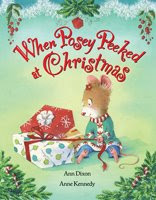My children grew up with Ann Dixon’s “The Sleeping Lady” and “Blueberry Shoe,” so it’s an honor to have the prolific Willow author here as our featured July guestblogger. Her latest book is When Posey Peeked at Christmas, released last fall. Thanks to Ann for conquering distance and some tech glitches to bring us this dispatch from Sweden.
Of course I love Alaska! I’ve lived here so long now that my identity as a human being — and a writer — is inextricable from my life in Alaska. But I have a confession: I love a couple other places, too. Places that formed who I am and to this day still nurture my spirit.
I’m writing to you now from one of those places, surrounded at the moment by people chattering amiably in a language I only half understand.
The Swedes have a word, trivs, for the feeling of well-being, of thriving, of being comfortable. I trivs in Sweden to such an extent that I feel nearly traitorous as an Alaskan. Yet in fact, Sweden is largely responsible for getting me to Alaska. After my first trip here, more than 30 years ago, I knew that the North was my homeland. At least in part, I came to Alaska seeking Sweden.
Sweden also turned me toward writing for children. Their literary tradition of innovative and imaginative children’s books goes back to the 1800s. As in Alaska, sense of place and the integration of nature and imagination are strong in both text and illustrations. Unlike Alaska — or the U.S. in general — picture books in Sweden frolic with good-natured irreverence and an openness about the facts of life that will either make you laugh or shudder, depending on your sensibilities.
In the past few days I’ve read several dozen Swedish picture books, both old and contemporary, by authors well-known in Sweden. My notes include comments like: “word count — too long for U.S.” and “too irreverent for U.S.” and “numerous naked bodies — yikes!” Yet each of these books is utterly delightful and respectful of children as human beings, and as readers.
As a writer of books for young children — and especially as a school librarian — I am acutely aware of what is acceptable, or not, in books for American children. I wonder if Swedish librarians have to deal with scribbled-over penises in classics like Maurice Sendak’s In the Night Kitchen and Paul Galdone’s The Shoemaker and the Elves?
Given Sweden’s social accomplishments, which include one of the lowest rates of teen pregnancy in the developed world, perhaps U.S. picture books could use a few more naked bodies! Certainly we could benefit from more willingness to deal honestly and meaningfully with the basics of life — love, sex, birth, death, and God, to name a few — as if they really matter.


Fascinating! With socialist-paranoia running rampant in our country, it's great to have a first-hand and measured perspective on the literature that reflects and perpetuates a value system that's, shall we say, more mature than ours. I have to keep reminding myself that America is a young country and Alaska an even younger state. Someday we too will grow up.
I find it so ironic that the human body is mostly kept hidden from children in books (unless they manage to find their way to the anatomy section of the library) but many, many children are exposed to TV shows, movies, and popular songs that are quite sexually explicit, and not particularly wholesome, shall we say.
A good start would be sculptures of human bodies in public places, I think. European kids grow up seeing naked statues all over the place! So it's no big mystery.
It seems to me, too, to be a matter of cultural maturity.
I agree completely, Ann. I used to take groups of students (from a rather conservative Alaskan community) to Europe, and was amazed that some were appalled at all the "nudity" on the streets. But then I've always been amazed at how there's no graffiti on public art in Europe. I shudder to think of the desecration of David if he were transplanted here. "Values" indeed.